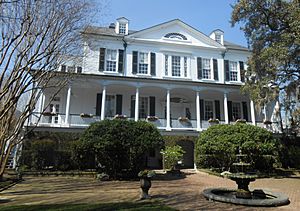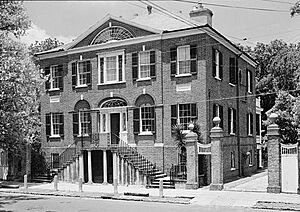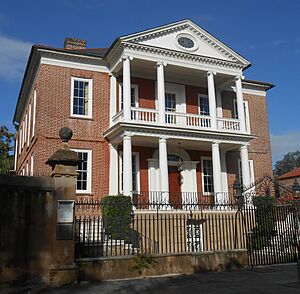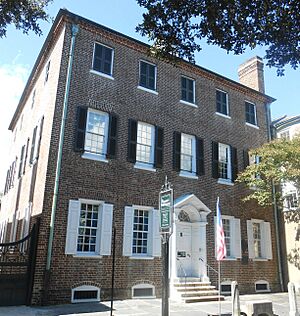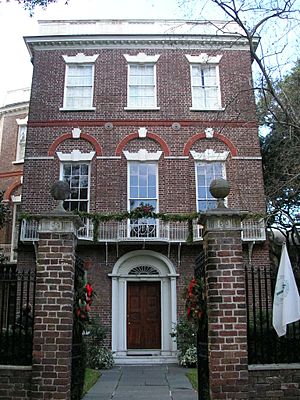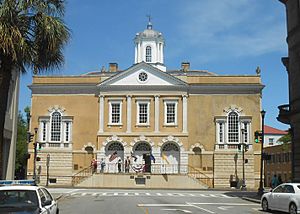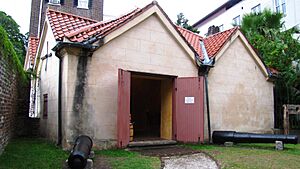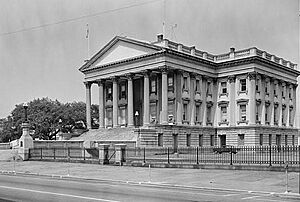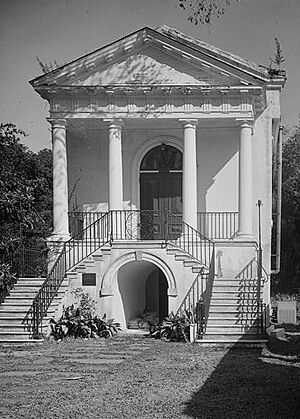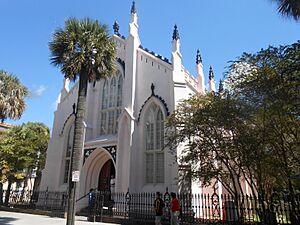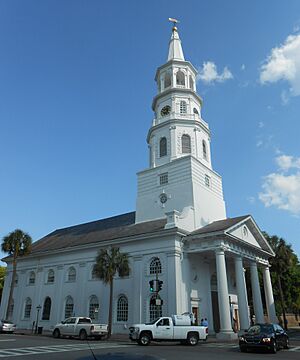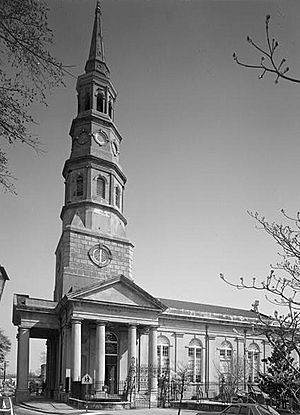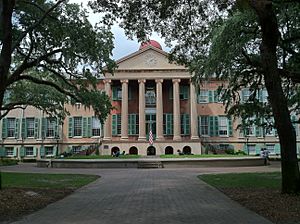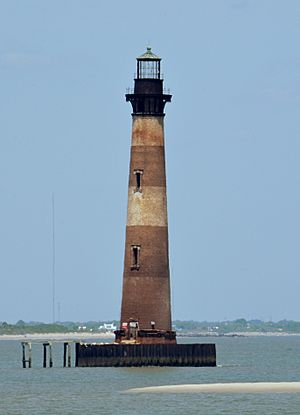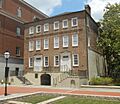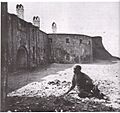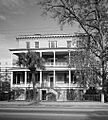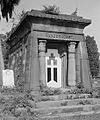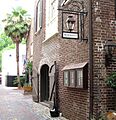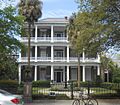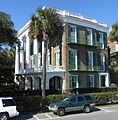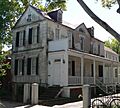National Register of Historic Places listings in Charleston, South Carolina facts for kids
Charleston, South Carolina, is a city full of amazing history! Many of its old buildings and special places are protected because they are listed on the National Register of Historic Places. This list helps keep important parts of American history safe for everyone to learn about and enjoy.
In Charleston County, there are 203 places listed on the National Register. Out of these, 43 are even more special and are called National Historic Landmarks. Charleston city itself has 103 of these important spots, including 34 National Historic Landmarks. This article will tell you about some of these fascinating places right here in Charleston.
Some historic places, like the Ashley River Historic District, Ashley River Road, and the Secessionville Historic District, are so big they stretch across both the city and other parts of Charleston County.
Contents
Exploring Charleston's Historic Gems
Charleston is home to many buildings and areas that tell stories from the past. Let's look at some of the most interesting ones.
Historic Homes and Buildings
Many old houses in Charleston are famous for their unique architecture and the people who lived in them.
William Aiken House and Railroad Structures
The William Aiken House at 456 King Street is a very important historic site. It was built in 1817 and is connected to early railroad history. William Aiken was a governor of South Carolina and a pioneer in building railroads. This house and its nearby railroad buildings show how important Charleston was in the early days of trains.
Gov. Thomas Bennett House
The Gov. Thomas Bennett House at 69 Barre Street was built in 1825. Thomas Bennett was also a governor of South Carolina. This house is a great example of the beautiful homes built in Charleston during that time.
William Blacklock House
The William Blacklock House at 18 Bull Street is a National Historic Landmark. Built around 1800, it's known for its unique design, which is different from many other Charleston homes. It shows a style called Federal architecture.
Miles Brewton House
The Miles Brewton House at 27 King Street is another National Historic Landmark. Built in 1769, it's one of the best examples of Georgian architecture in America. It's a grand mansion that has been home to the same family for generations.
Heyward-Washington House
The Heyward-Washington House at 87 Church Street is a National Historic Landmark. Built in 1772, it's famous because George Washington, the first President of the United States, stayed here during his visit to Charleston in 1791. It's now a museum where you can see how people lived in the 18th century.
Nathaniel Russell House
The Nathaniel Russell House at 51 Meeting Street is a National Historic Landmark. Built in 1808, this house is famous for its beautiful spiral staircase that goes up three stories without any visible support! It's a stunning example of Neoclassical architecture.
Joseph Manigault House
The Joseph Manigault House at 350 Meeting Street is a National Historic Landmark. Built in 1803, this house is a great example of Adam style architecture. It's now a museum that shows what life was like for wealthy families in Charleston.
Important Public Buildings and Landmarks
Charleston also has many public buildings and landmarks that played a big role in its history.
The Exchange and Provost
Located at East Bay and Broad Streets, the Exchange and Provost is a National Historic Landmark. Built in 1771, this building has served many purposes. It was a place for merchants to trade goods, a prison during the American Revolution, and even a post office. It's a symbol of Charleston's long history.
Fireproof Building
The Fireproof Building at 100 Meeting Street is a National Historic Landmark. Built in 1827, it was designed to protect important records from fires, which were a big danger in old cities. It's considered one of the earliest fireproof buildings in the United States.
Market Hall and Sheds
The Market Hall and Sheds at 188 Meeting Street is a National Historic Landmark. Also known as the Old City Market, this area has been a bustling marketplace since the early 1800s. The Market Hall itself was built in 1841 and is a beautiful example of Greek Revival architecture. The sheds behind it are still used by vendors today.
Powder Magazine
The Powder Magazine at 79 Cumberland Street is a National Historic Landmark. Built around 1713, it's the oldest public building in South Carolina. It was used to store gunpowder for the city's defense. It's a small but very important building that reminds us of Charleston's early days as a walled city.
U.S. Customhouse
The U.S. Customhouse at 200 East Bay Street is a grand building completed in 1879. It was built to handle the busy trade coming through Charleston's port. Its impressive architecture shows the importance of trade to the city.
Historic Churches and Synagogues
Charleston is known for its many historic places of worship, showing its diverse past.
Circular Congregational Church
The Circular Congregational Church at 150 Meeting Street is a National Historic Landmark. The current building was finished in 1892, but the congregation dates back to 1681, making it one of the oldest churches in the South. Its unique circular design is very striking.
Huguenot Church
The Huguenot Church at 136 Church Street is a National Historic Landmark. Built in 1845, it's the only active Huguenot church in the United States. Huguenots were French Protestants who came to Charleston seeking religious freedom.
Kahal Kadosh Beth Elohim Synagogue
The Kahal Kadosh Beth Elohim Synagogue at 90 Hasell Street is a National Historic Landmark. Built in 1840, it's one of the oldest synagogues in the United country and an important site for Jewish history in America.
St. Michael's Episcopal Church
St. Michael's Episcopal Church at 80 Meeting Street is a National Historic Landmark. Completed in 1761, it's the oldest church building in Charleston and has a famous steeple that can be seen from far away. Its bells have rung for many important events in history.
St. Philip's Episcopal Church
St. Philip's Episcopal Church at 146 Church Street is a National Historic Landmark. The current building was finished in 1838, but the church's history goes back to 1680. Many famous South Carolinians are buried in its graveyard.
Unitarian Church
The Unitarian Church at 6 Archdale Street is a National Historic Landmark. Built in 1772, it's known for its beautiful Gothic Revival architecture, which was added later in the 1800s. It's a peaceful and historic place.
Other Significant Historic Sites
Charleston has many other unique places that are part of its rich history.
Fort Sumter National Monument
Fort Sumter is a famous sea fort in Charleston Harbor and a National Historic Landmark. This is where the first shots of the American Civil War were fired in April 1861. It's a very important site for understanding American history.
College of Charleston
The College of Charleston is a National Historic Landmark. Founded in 1770, it's the oldest college in South Carolina and one of the oldest in the United States. Its historic campus includes beautiful old buildings like Randolph Hall.
Drayton Hall
Drayton Hall, located about 12 miles west of Charleston on Highway 61, is a National Historic Landmark. Built between 1738 and 1742, it's one of the oldest unrestored plantation houses in America. It's a rare example of Palladian architecture and shows what life was like in the colonial era.
Morris Island Lighthouse
The Morris Island Lighthouse is located about 6 miles southeast of Charleston. This historic lighthouse, built in 1876, stands alone in the water now due to erosion, but it remains a beloved symbol of Charleston's maritime history.
Site of Old Charles Towne
The Site of Old Charles Towne at Albemarle Point is where the first permanent English settlement in South Carolina was established in 1670. It's now part of a state historic site called Charles Towne Landing, where you can learn about the early days of the colony.
Historic Districts
Some areas of Charleston are so full of history that entire neighborhoods are protected as historic districts.
Charleston Historic District
The Charleston Historic District is a very large area that covers much of the historic peninsula. It's a National Historic Landmark District because it contains so many important buildings and streets that show the city's long history and unique architecture. Walking through this district is like stepping back in time.
Charleston's French Quarter District
The French Quarter District is a charming part of Charleston bounded by Lodge Alley, Cumberland, East Bay, and State Streets. This area gets its name from the many French Huguenots who settled here. It's known for its narrow streets, historic buildings, and art galleries.
Ashley River Historic District
The Ashley River Historic District follows the Ashley River and includes many historic plantations and homes. This district shows the rich agricultural history of the area and the grand estates that were built along the river.
Secessionville Historic District
The Secessionville Historic District is located on James Island. This area was the site of an important Civil War battle in 1862. Protecting this district helps preserve the memory of the events that took place there.
Former Listings
Sometimes, a historic place might be removed from the National Register. This usually happens if the building is destroyed or changes too much.
Shaw Community Center
The Shaw Community Center at 22 Mary Street was once listed on the National Register. However, it was later taken off the list in 1974 because it was torn down to build a new Boys & Girls Club.
Images for kids




